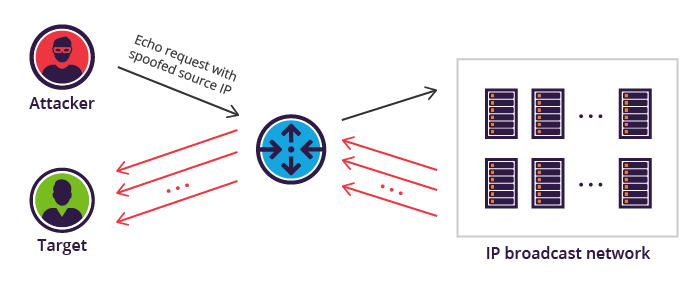Smurf Attack
What is a Smurf attack
Smurf is a network layer distributed denial of service (DDoS) attack, named after the DDoS.Smurf malware that enables it execution.
Smurf attacks are somewhat similar to ping floods, as both are carried out by sending a slews of ICMP Echo request packets.
Unlike the regular ping flood, however, Smurf is an amplification
attack vector that boosts its damage potential by exploiting
characteristics of broadcast networks.
Attack description
In a standard scenario, host A sends an ICMP Echo (ping) request to host B, triggering an automatic response. The time it takes for a response to arrive is used as a measure of the virtual distance between the two hosts.
In an IP broadcast network, an ping request is sent to every host, prompting a response from each of the recipients. With Smurf attacks, perpetrators take advantage of this function to amplify their attack traffic.

Here's How a Smurf attack works:
First the Smurf malware builds a spoofed packet that has its source address set to the real IP address of the targeted victim.
The packet is then sent to an IP broadcast address of a router or firewall, which in turn sends requests to every host device address inside the broadcasting network, increasing the number of requests by the number of networked devices on the network.
Each device inside the network receives the request from the broadcaster and then responds to the spoofed address of the target with an ICMP Echo Reply packet.
The target victim then receives a deluge of ICMP Echo Reply packets, potentially becoming overwhelmed and resulting in denial-of-service to legitimate traffic.
How can a Smurf attack be mitigated:
Several mitigation strategies for this attack vector have been developed
and implemented over the years, and the exploit is largely considered
solved. On a limited number of legacy systems, mitigation techniques may
still need to be applied. A simple solution is to disable IP
broadcasting addresses at each network router and firewall. Older
routers are likely to enable broadcasting by default, while newer
routers will likely already have it disabled. In the event that a Smurf
attack occurs, Cloudflare eliminates the attack traffic by preventing
the ICMP packets from reaching the targeted origin server. Learn more about how Cloudflare's DDoS Protection works
Comments
Post a Comment